|
|

Enakyo is a scenic, gorge-like area along the Kiso River. Noted for cherry blossoms in spring, autumn colors in November, and unusual rock formations.
|
|

Enakyo or Ena Gorge is in the city of Ena (pop. 47,000 as of Nov. 2021) next to Nakatsugawa in eastern Gifu Prefecture.
|
|
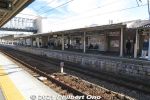
Nearest train station is JR Ena Station on the JR Chuo Line. It's about 70 min. from Nagoya Station in Aichi Prefecture.
|
|
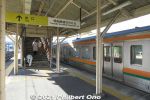
JR Ena Station platform and JR Chuo Line.
|
|

JR Ena Station has a tourist information center right inside and outside.
|
|
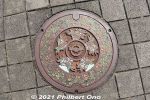
Manhole in Ena, Gifu.
|
|
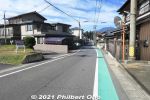
There are buses running from JR Ena Station to Enakyo Gorge, but they run very infrequently. Since the next bus was a one-hour wait (and 15-min. ride), I decided to walk it and not miss the sunny day. I was told it would take 1 hour. Or ¥2,000 by taxi.
|
|
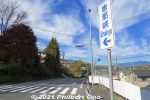
Walking to Enakyo. The tourist information lady gave me a map to walk to Enakyo. Easy to follow.
|
|
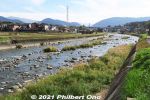
Agi River.
|
|
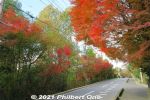
There were a few maple (momiji) trees along the way.
|
|
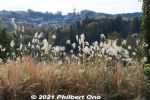
Pampas grass too.
|
|
|
|
|
|
|
|
|
|
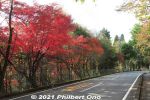
Although I was rewarded with these red maples, one-hour is kind of a long walk. Slight uphill too.
|
|
|
|
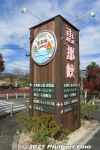
Finally, the Enakyo sign.
|
|

Enakyo marker sign.
|
|

Enakyo bus stop.
|
|
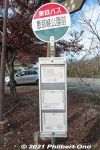
If you take a bus, get off here at Enakyo Koen-mae. Also check the return bus schedule. Buses run very infrequently.
|
|
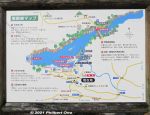
On this map of Enakyo Gorge, No. 3 and 4 are Sazanami Park, No. 5 is the boat cruise pier, and No. 2 is Oi Dam which created this river reservoir.
|
|
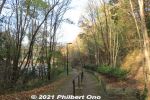
From the bus stop, there's a short path down to the riverside.
|
|
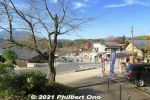
Cross the road and there's the starting point to explore Enakyo. Building on the left is the Visitors' Center.
|
|

Map of Enakyo. There's a sightseeing boat pier on the left, a few hotels, and a small spit of land that is Sazanami Park, one main attraction.
|
|

Most tourists visiting Enakyo will first arrive here, a short walk from the bus stop and parking lot. The "Y" is missing here. Maybe it was designed to have a human posing as the "Y" in a selfie.
|
|
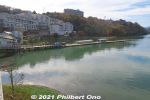
On the left is a pier for sightseeing boats taking tourists to see the unusual rock formations on the gorge. Cruise is 30 min. and fare is ¥1,500. Runs often during autumn. https://www.tohsyoh.jp/ship
|
|
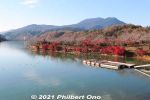
On the right is Sazanami Park lined with autumn maple leaves in November and cherry blossoms in spring. Everything is within a short walk. These photos were taken in November.
|
|
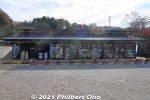
Enakyo Visitors Center has tourist information counter and air-conditioned rest area with tables and chairs.
|
|
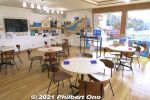
Inside Enakyo Visitors Center.
|
|

Sights in Enakyo Gorge.
|
|

Sights and wildlife in Enakyo Gorge.
|
|
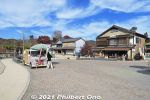
Gift shops at Enakyo.
|
|
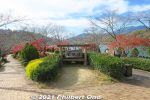
Entering Sazanami Park lined with red maple trees in autumn. "Sazanami" means "water ripples."
|
|
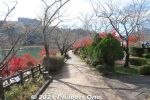
Sazanami Park has a small peninsula with a walking path lined with maple trees (and cherry trees).
|
|
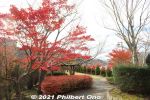
Entering Sazanami Park lined with red maple leaves in mid-November.
|
|
|
|
|
|
|
|
|
|
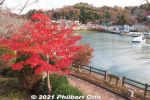
Left side of Sazanami Park facing the boat pier.
|
|
|
|
|
|
|
|
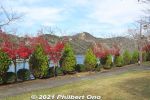
The park has two levels. Lower level is a path along the riverside, and this upper level is a park-like lawn.
|
|
|
|
|
|
|
|
|
|
|
|
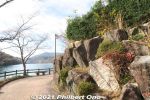
Approaching the tip of Sazanami Park.
|
|
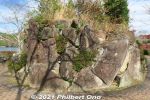
Rocks on the tip of Sazanami Park.
|
|

View of Kiso River from the tip of Sazanami Park. Right below Shinonome Ohashi Bridge (東雲大橋) in the distance is Oi Dam built in 1924 as Japan's first hydroelectric dam. The dam created this reservoir in Ena Gorge.
|
|
|
|
|
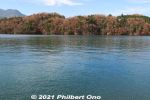
View of the river from the right side of Sazanami Park.
|
|

Upstream toward Enakyo Ohashi Bridge.
|
|

On the right side of Sazanami Park, Ena-kyo Wonderland can be seen on the mountain. An amusement park, closed for winter from Nov. to Feb..
|
|
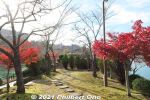
On the upper level of Sazanami Park, looking toward the tip.
|
|
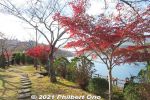
On the upper level of Sazanami Park, looking toward the tip.
|
|
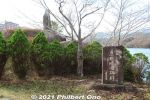
Tanka poetry monument on the tip of Sazanami Park. Lower monument commemorates the development of Enakyo.
|
|
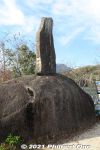
Tanka poem monument for poet Kitahara Hakushu.
|
|
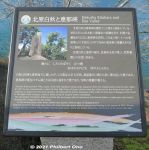
About the tanka poem by poet Kitahara Hakushu.
|
|
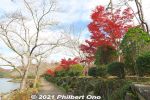
Red maple leaves on the right side of Sazanami Park.
|
|
|
|
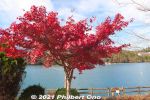
Most maple trees aren't that large, but the river in the background makes them scenic.
|
|
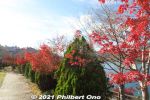
Definitely the right place for red maple leaves. Most were already very red.
|
|
|
|
|
|
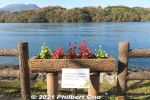
Flowers grown and groomed by Ena Agricultural High School students studying landscape design.
|
|
|
|
|
|
|
|
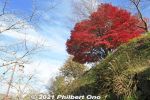
Big maple tree.
|
|
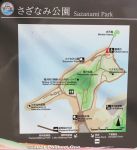
Map of Sazanami Park. You can walk around it in 15-20 min. (Longer if you like to take pictures.)
|
|
|
|
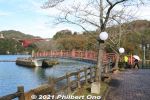
From Sazanami Park, a bridge to Benten Island.
|
|

Bridge to Benten Island.
|
|

Benten Island has a statue of the goddess Benzaiten.
|
|
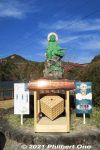
Statue of the goddess Benzaiten and shiny offertory box.
|
|
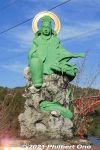
Statue of the goddess Benzaiten, protector against floods and water accidents. Goddess of anything that flows, including music.
|
|
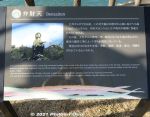
Benten Island is the tip of a mountain now submerged by the dammed river.
|
|
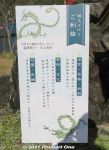
Pray to Benzaiten for success in life, passing exams, love, and art and design.
|
|
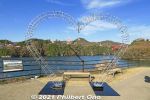
Upper level of Sazanami Park.
|
|

View of Benten Island.
|
|
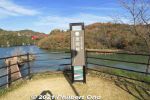
Lookout point on Sazanami Park.
|
|
|
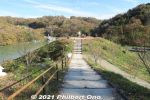
Small hill called Hanamomo-no-Oka.
|
|
|
|
|

Momosuke Square at the top of Sazanami Park. Statue of Fukuzawa Momosuke, son-in-law of Fukuzawa Yukichi. Momosuke built the Oi Dam that created this Enakyo reservoir and hydroelectric power.
|
|
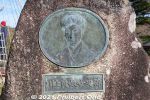
Relief of Kawakami Sadayakko (or Sada Yacco 1871–1946) who was Momosuke's mistress and former geisha who was also previously mistress to Prime Minister Ito Hirobumi. She helped Momosuke build and design seven dams along Kiso River. 川上 貞奴
|
|
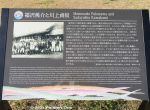
About Fukuzawa Momosuke and Kawakami Sadayakko. Momosuke was inspired by father-in-law Yukichi who said electricity was necessary for Japan's economic development and mechanization.
|
|
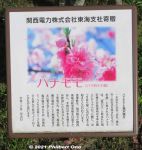
From Germany where he bought water wheels for his hydroelectric power plant, Momosuke brought Hana peach flowers (hanamomo) to Japan.
|
|
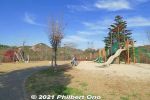
Also a playground for kids.
|
|
|
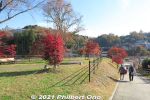
Going back down from Sazanami Park.
|
|
|
|

Gift shops on the way back to the bus stop.
|
|
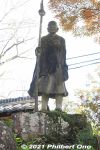
Statue of Buddhist priest Kobo Daishi near the bus stop. Built around 1932 in memory of those who died while building Oi Dam. It was also built to attract tourists. Kobo Daishi founded Shingon Buddhism.
|
|
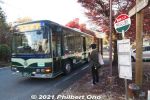
Bus to Ena Station (about 15 min.). They run very infrequently, so be sure to check the return bus schedule.
|
|
|
|